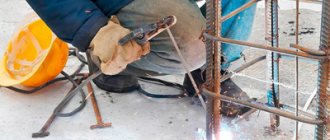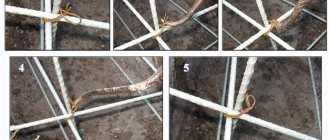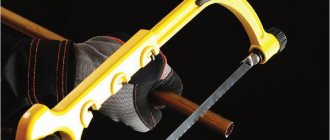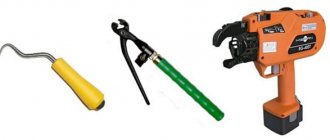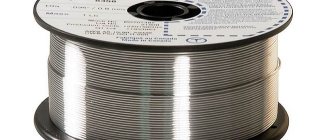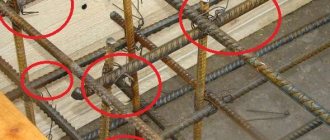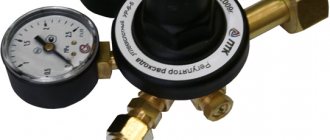The foundation is the foundation of a structure that supports the main load. For this reason, it needs to be built from durable materials with good wear and tear. Particular attention should be paid to the fastening elements that will hold the structure and also protect it from premature destruction. The most suitable option is fiberglass reinforcement for the foundation. This is a new material that has recently become very popular. But first, it’s worth considering its advantages and important features.
What is fiberglass reinforcement
Fiberglass reinforcement is a whole system of glued glass fibers.
A polymer composition is used as a binder. Typically, the reinforcement has the form of a rod, which has several constituent elements:
- main trunk It has a core that consists of parallel fibers. They are glued together using polymer resin. This ensures high structural strength;
- outer shell. The sheath fibers are wound around the AKS barrel in a spiral sequence. Sometimes sand spraying is used.
How to produce
Composite rods are made in three ways:
- Needletrusion. During the procedure, individual fibers are twisted into one and at the same time impregnated and braided. Since such technological lines operate at high speed, the process does not require large financial costs, which also affects the price. In order for the reinforcement to acquire a characteristic relief, it is wrapped with threads and a periodic profile. The thickness of the rods depends on the number of threads. This manufacturing method allows us to obtain products that have good adhesion to concrete.
- Plaintrusion. First, the main rod is formed, after which it is wrapped in a spiral in two directions.
- Pultrusion. This is the oldest technique. First, the fiber is formed and impregnated, and when it hardens, it is pulled through a spinneret. This system operates at the polymerization temperature of the plastic and allows the final forming and stretching of the reinforcement. The cost of the material obtained by this method is higher, and the production speed is low.
There are smooth or profiled products.
Advantages and disadvantages
Fiberglass reinforcement is an excellent option for strengthening the foundation. This material increases its strength, increases service life and allows it to withstand high loads.
If you are thinking which reinforcement is better - fiberglass or metal, it is worth considering the important positive features of composite reinforcement over steel :
- a light weight. Compared to metal products, composite reinforcement is 9 times lighter. For this reason, you do not need to use special expensive equipment to install it;
- fiberglass elements are highly resistant to chlorine and other acidic, aggressive substances. Compared to steel products, the stability coefficient of composite products is 10 times higher;
- low level of thermal conductivity. Due to the fact that the reinforcement heats up and cools down, it does not cause destruction of the internal part of concrete structures;
- Composite products have the properties of dielectric non-conductivity and electromagnetic permeability. This means that they cannot conduct electricity and do not interfere with radio waves;
- have tensile strength. Compared to metal, it is 2-3 times higher;
- increased resistance to corrosion;
- easy transportation;
- low price. Compared to metal products, fiberglass rods are much cheaper.
Do not forget about the disadvantages of composite products:
- Fiberglass reinforcement has a low modulus of elasticity and can be easily bent. During the construction of the foundation and paths, this drawback is not noticeable. But if the products are used in the construction of floors, then this nuance should not be missed; it is important to carry out all the necessary calculations;
- The products have an insufficient level of heat resistance. You should not combine fiberglass reinforcement with concrete mortar under strong temperature changes, otherwise it may completely lose its binding properties;
- fragility. Over time, composite products wear out and begin to deteriorate; exposure to an alkaline environment also has a huge impact on rapid wear. But manufacturers, in order to increase the service life of fiberglass reinforcement, began to add rare earth metals to its composition;
- not intended for welding.
Technical characteristics and scope of use
Composite fiberglass reinforcement, characteristics:
- thermal conductivity – 0.35 W/(m*K);
- relative elongation – 8-10%;
- service life – at least 100 years;
- elastic modulus – 55000-56000 MPa;
- tensile strength – from 480 MPa to 1600 MPa;
- coefficient of linear thermal expansion – from 9 * 10-5 C0 to 12 * 10-5 C0;
- weight – from 49 g to 440 g per linear meter (depending on the type and thickness);
- the diameter of the glass fibers is 13-16 microns.
Plastic reinforcement can be different, so it would not be amiss to conduct a comparative analysis of several types of this building material (see table No. 1).
Table No. 1. Comparison of different types of composite plastic
fittings according to technical characteristics.
| Characteristics/types | ACC | ASK | AUK | ABK | AAK |
| Strength when performing a cross-section, limit (in megapascals) | 190 | 150 | 350 | 150 | 190 |
| Tensile response: elastic modulus (megapascals) | 100 | 50 | 130 | 50 | 70 |
| Tensile strength, limit (in hectopascals) | 1000 | 800 | 1400 | 800 | 1400 |
| Compressive strength, limit (in megapascals) | 300 | 300 | 300 | 300 | 300 |
The use of durable glass reinforcement for the foundation Source sibarmatura.com
Reinforcement calculation
When building a foundation with your own hands, it is important to correctly calculate the necessary materials, including fiberglass reinforcement. The calculation must be carried out in accordance with the following important nuances:
- The correct determination of the base length parameters must be carried out. When taking measurements, it is necessary to take into account the length of the internal load-bearing partition;
- it is required to calculate the length of the reinforcing rods. It should be taken into account that the reinforcing elements will be placed in several tiers;
- you need to determine the number of places with connections. Composite products are joined not by welding, but by overlap. For this reason, 100 cm is added to the area of each corner;
- Calculations must be carried out for transverse connections.
To understand exactly how the calculation of fiberglass reinforcement bars is performed, it is worth considering an example using the parameters of a house with a base size of 12x12 meters, which was made using tape technology.
During the calculation the following actions will be performed:
- the perimeter of the house is calculated. P = 2*(12+12) = 48 m;
- the total length of the reinforcement elements, which are stretched into two tiers of 4 edge bars, will be calculated as follows - D = 48 * 4 = 192 m.
- the number of jumpers must be calculated taking into account the minimum permissible run-up of 0.5 meters. In an example it looks like this, P = 48/0.5 = 96 pieces;
- Calculations of the perimeter of the frame (500x500 mm) must be carried out. Pk = (0.5+0.5)*2 = 2 m;
- calculations are made of the length of the reinforcing rings - Dk = 96 pcs * 2m = 192 m. In this case, trimming must be taken into account - 192 + 5% = 202 m;
- in the end you will need - 192 + 202 = 394 meters of product with the same profile;
- It is worth calculating the required number of clamps for knitting - X = 96 pcs * 4 = 384 pcs.
Optional conclusions
When choosing, you need to take into account both your financial capabilities and the advice of professionals, as well as building regulations. Only in this case can you achieve the creation of a high-quality foundation that can withstand not only heavy loads, but also various unfavorable conditions that can cause damage.
Particular attention should be paid to the type of reinforcement that will be used during the creation of the foundation. The choice of reinforcement is the most important and critical stage during the construction of the foundation of any structure. If any mistakes are made at this stage, then even the best builders and materials will not help create a reliable building.
If you don’t know which fittings to choose, then contact the services of a foreman, he will determine exactly which fittings for your home will be better, plastic or metal. A team of professionals will perform foundation reinforcement and concrete work quickly and efficiently in the Rostov region.
Rules for working with fiberglass reinforcement
In order for the composite material to protect and strengthen the foundation, it is recommended to follow important recommendations when working with it:
- Rebar cutting is done using a hot torch or bolt cutter. Sawing polymer reinforcement products with any other devices causes the formation of harmful microscopic chips;
- bending of reinforcement is allowed only in the manufacture of structural reinforcement products. This process is performed using an electric hair dryer; this tool heats the bent area to 100-1200C, and then, after taking the required shape, everything is cooled;
- the fittings should be stored in a cool, dark place, protected from sunlight;
- When unwinding coils with rods, it is recommended to take into account the degree of elasticity of the composite material. To relieve its strong tension, one end of the reinforcement must be secured for some time to the coil body using a meter-long piece of chain.
Areas of application: can fiber replace conventional reinforcement?
Theoretically, polypropylene (or any other) fiber can replace traditional steel reinforcement. But in practice, no, since it is impossible to ensure a completely uniform design distribution of the fiber when mixing the solution. With ordinary fittings, it is always clear: how much there is, where and how it lies. With fiber, not everything is so simple. In this regard, polypropylene fiber is not suitable for the production of foundations and load-bearing structures (beams, slabs, etc.) that accept multi-ton loads. However, in these cases it can be used in conjunction with classical reinforcement: this will save concrete and improve its performance properties (which were mentioned above). In all other areas, fiber easily replaces conventional steel reinforcement completely. Its use is absolutely justified (both economically and technically) when you need to make a sidewalk, curbs, or road; pour a concrete parking lot or the foundation of a small one-story private house; equip flooring, screed, industrial flooring in warehouse or industrial premises.
How to reinforce a foundation with fiberglass reinforcement
Fiberglass reinforcement is often used for strip foundations. It strengthens it, enhances its strength. But in order for the reinforcement process to proceed correctly, it should be approached with all responsibility.
Preparation
When using composite products for the base, it is worth preparing the necessary tools for the job:
- to take the required measurements you will need a tape measure;
- Bulgarian. This tool is needed for fitting and cutting fiberglass rods;
- personal protective equipment;
- water level;
- plastic clamps. They are necessary to connect the rods.
At the preparatory stage, you need to dig a trench. It is carried out according to the data specified in the project of the future structure. Important features of earthworks include:
- After digging the trench, it is recommended to level and compact the bottom well;
- then sand is poured in the form of a layer, its thickness should be 10-15 cm;
- the layer is watered and thoroughly compacted;
- crushed stone is poured on top of the sand with the same thickness as sand and thoroughly compacted;
- As a result, a kind of cushion of sand and crushed stone is formed at the bottom.
It is important to do everything correctly. The bottom of the trench should be perfectly flat so that after laying the fiberglass reinforcement there are no distortions. This will require the use of a water level.
Construction of formwork
For a strip foundation, formwork is required; it gives it the required shape and protects it from distortions.
It is made from boards that are connected in the form of shields. It is recommended to use nails and screws for fastening. The caps of fasteners should be located on the inside. Additionally, the structure should be strengthened with special spacers. The surface of the formwork walls is covered with polyethylene film, which is attached using a construction stapler. The use of film is desirable; it will keep the boards clean and also prevent liquid from leaking out of the concrete mixture.
On the walls of the formwork it is necessary to mark the level to which the concrete solution will be poured. It will also serve as a guide when installing a frame made of fiberglass reinforcement. To get everything right, you should use a water level.
Features of the construction of a frame made of reinforcement
After installing the formwork, reinforcement must be carried out. When constructing a frame, the following important conditions should be observed:
- since the frame is completely filled with concrete, when installing the reinforcing mesh it is important to maintain a distance of at least 5 cm from the formwork walls;
- so that the reinforcing material is not installed directly at the bottom of the trench, it is worth placing additional bricks;
- then longitudinal rods of fiberglass reinforcing material are laid on the bricks in two rows, as well as horizontal rods that are crossed;
- Many novice builders often have the question of how to knit transverse and longitudinal rods. For this purpose, plastic clamps are used;
- after this, the vertical rods are also tied. The result should be cells with dimensions of 15x15 cm.
After constructing the frame, the concrete mixture can be poured. It is recommended to pour the solution carefully; it should completely fill the space between the frame elements. Be sure to periodically pierce the concrete with a metal rod, this will eliminate air voids.
Reviews from experts advise using a level when carrying out all work. It will allow you to do everything correctly and smoothly. As a result, there will be no distortions, bends and deformations, which can lead to further problems during construction.
Video: How to knit fiberglass reinforcement
Application of material
We decided to take a closer look at the areas of application of fiberglass reinforcement in the country, and we will give some examples for this.
Bandaging the foundation for country houses
The material can be used to reinforce foundations for low-rise construction, for the construction of a summer kitchen, gazebo, shower and toilet, stove and barbecue, sauna and barn.
The reinforcement is plastic and does not require special skills for assembly. It is enough to place it in the place where the foundation is poured, bandage it and pour the concrete. Due to its characteristics, the reinforcement will qualitatively strengthen the foundation, prevent it from cracking and will not serve as “cold bridges” like steel.
Pouring reinforced areas
At the dacha, areas are often required, for example, for parking a car, for creating a canopy, and so on. We use different materials for their construction - paving slabs, masonry, simple backfilling with crushed stone, but you can always make a high-quality concrete platform reinforced with fiberglass reinforcement. What is important here is the correct calculation of the depth and dressing, then only the simplest installation and laying of high-quality concrete.
Greenhouse for a summer residence made of composite reinforcement
We built greenhouses from pipes, steel reinforcement, metal profiles, wood, metal corners and other materials, but now we have the opportunity to install a spring greenhouse in a matter of hours, with virtually no costs.
We only need to cut the rods to the required length and install them in a wooden frame or directly into the ground. Afterwards, stretch the film over the top, bring high-quality fertile soil inside and begin planting.
Since the reinforcement is light but durable and is not afraid of moisture and oxidation, such a greenhouse will have only one drawback - the film, which will have to be changed every year or two.
Reinforcement trellis
We have already considered trellises made of wood, pipes, thick wire and other materials earlier. But now you can simply cut pieces of reinforcement from a skein, install a couple of supports for vertical gardening, and make the frame out of composite material. You won’t have to spend a long time tightening bolts and nuts, welding, or hiring specialists. It will be enough to tie the frame with clamps, applying pieces of reinforcement to the main supports in the right place, and manually tightening the clamps.
In addition, strong and durable reinforcement can be used for supports in the garden and garden. You can easily make pegs for flowers and ornamental shrubs, peppers and tomatoes.
The use of fiberglass reinforcement in a dacha is not only possible , but moreover, completely justified! It is cheaper than steel, easy to install, great for serious and light structures, does not require special equipment and fits perfectly into the design of the garden and lawn, as it can be selected in different shades. The material will last for many years without painting or protective agents, will help you save money and increase the practicality of working in the country.
Knitting features
You need to find out how to knit plastic reinforcement for the foundation in order to carry out the procedure correctly. A high-quality and reliable foundation is the guarantee that the house will last a long time. Therefore, reinforcement of the base is an important stage of construction.
Most often, strip foundations are used for buildings. For this purpose, the knitting of plastic reinforcement is carried out with some special features. This procedure helps to make the structure uniform and durable. The rods are tied at their intersections. This is done with wire or special means.
The wire is bent in the middle, after which it is put on a hook, applied to the reinforcement and tightened. This is quite difficult, so a plastic tie will help make the job easier.
Plastic shut-off valves are considered an important element of the reinforcing system. It helps to more firmly attach individual rods to each other.
Fasteners are popular among builders. These are embedded parts that create a protective layer of a certain thickness in concrete.
Such clamps are made of polyethylene. They are poured under high pressure. They provide reliable fastening of reinforcing bars, frames and allow you to obtain a strong concrete or reinforced concrete structure. Clamps are used in horizontal and vertical surfaces, and they are also used to create formwork.
